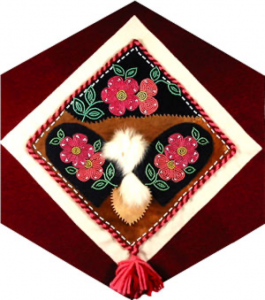Dogrib

The Block
Block-maker Celine Mackenzie Vukson carefully chose elements that would reflect her heritage and history. The Dogrib are known for their resourceful and recycling nature. She used the beaded “uppers” and a leg part from a pair of mukluks (made by her mother years ago) to show the Dene way of life and ability to survive in an extremely cold climate. A variation of a popular design–the northern wild rose–is produced in bright pink beads on a navy stroud background.
Caribou hide segments are edged with “pinking” made in the traditional manner, folding over a piece of leather and cutting it with sharp scissors. The pink and burgundy twisted yarn is a reminder of her mother’s perseverance in learning how to make such yarn as a young bride. The pieces of hide honour all Dogrib women who, while they cared for large families, would sit for hours huddled against the cold scraping, stretching and tanning hides. And finally, precious pieces of sinew thread, made three decades earlier by her grandmother, were used as a tangible connection to her Dogrib roots.
Cultural Profile
Historically, known as nomadic hunters and trappers, the Dogrib are now located in the Northwest Territories between Great Slave Lake and Great Bear Lake. The Dogrib are also called Thlingchadinne, meaning “Dog-flank People”, in reference to their legend that tells how the Dogrib are descended from a supernatural dog-man. They are among the most numerous members of the Dene Nation. Over 2,000 Dogrib still fluently speak their native language, belonging to the Athapaskan language family.
Their nomadic lifestyle meant that the Dogrib had a different idea of home than the typical Western conceptualization. Home was not the caribou-hide shelter they carried on their travels, home was the vast territory of forests, lakes and rivers surrounding them. This meant that everywhere they went they were still at home, an indication of their close relationship to the land. They hunted primarily from the Bathurst caribou herd, but supplemented their diet with fish. Dogrib women like to use exquisite beadwork, fancy silk and wool embroidery stitches and an abundance of fur trimmings on their clothing, often made from caribou hide and fine wool stroud.
In August 2003, the Dogrib signed an historic self-government and land claim settlement with the federal and territorial governments. The Tli Cho (which means Dogrib) agreement gives 3,000 Dogrib ownership of the 39,000 sq. km. of land in which they are located. The words of this agreement are derived from those spoken by honoured and respected Chief Monfwi when he signed Treaty 11, 82 years earlier.
Sponsor: Dogrib Rae Band
